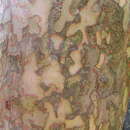mk
имиња во трошки


Ulmus lamellosa, commonly called the Hebei elm, is a small deciduous tree native to four Chinese provinces, Hebei, Henan, Nei Mongol, and Shanxi, to the west and south of Beijing.[1][2]
A slow growing tree rarely exceeding 10 m in height, U. lamellosa is often multi-stemmed, its upright branches forming a rounded crown, but occasionally forms a single, slender trunk < 20 cm d.b.h. Considered closely related to the Large-fruited Elm U. macrocarpa, it is distinguishable from that species by its mottled, flaking bark and smaller leaves. The leaves, on 3–8 mm petioles, are obovate, < 10 cm long by 5.5 cm wide, caudate at the apex, with simply to doubly serrate margins, and densely pubescent when young; the leaves turn a rich gold in autumn. The perfect wind-pollinated apetalous flowers are produced on second-year shoots in March–April; the large < 35 mm diameter samarae appear from April to May.[1]
In the trials at the Morton Arboretum, Illinois, U. lamellosa was found to have a good resistance to Dutch elm disease.[3] The species was also found to be among the least suitable elms for feeding and reproduction by the Japanese Beetle Popillia japonica [4] in the United States.
Rare in cultivation beyond China, it is one of a number of Chinese species which were assessed for their horticultural merit at the Morton Arboretum, where it was adjudged suitable for planting in parks and gardens, but found to be typically intolerant of wet soils.[3] Although known to propagate satisfactorily, U. lamellosa is only very rarely found in commerce in Europe and the United States; there are no known cultivars.
Ulmus lamellosa, commonly called the Hebei elm, is a small deciduous tree native to four Chinese provinces, Hebei, Henan, Nei Mongol, and Shanxi, to the west and south of Beijing.
Ulmus lamellosa là một loài thực vật có hoa trong họ Ulmaceae. Loài này được C. Wang & S.L. Chang miêu tả khoa học đầu tiên năm 1979.[1]
Ulmus lamellosa là một loài thực vật có hoa trong họ Ulmaceae. Loài này được C. Wang & S.L. Chang miêu tả khoa học đầu tiên năm 1979.
脱皮榆(学名:Ulmus lamellosa)是榆科榆属的植物,是中国的特有植物。分布在中国大陆的辽宁、河北、河南等地,目前已由人工引种栽培。
沙包榆(辽宁熊岳)